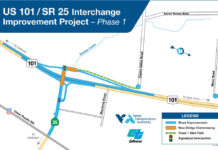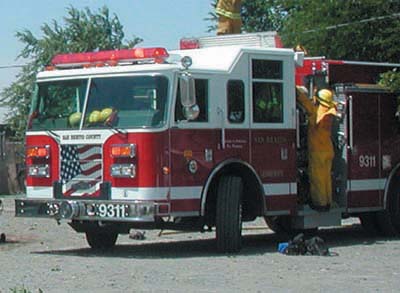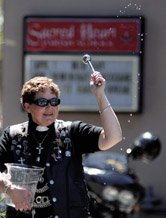The first draft of a key new transportation study reveals what
everyone already knew: huge numbers of travelers depend on South
Valley roads to reach the Bay Area, and the roads we have now can’t
handle the traffic.
By Matt King Staff Writer
The first draft of a key new transportation study reveals what everyone already knew: huge numbers of travelers depend on South Valley roads to reach the Bay Area, and the roads we have now can’t handle the traffic.
The Southern Gateway Transportation and Land Use Study, now circulating in draft form, recommends a massive redesign of the South Valley landscape, with a series of improvements and new roads in Santa Clara and San Benito counties.
The need is so great that the Santa Clara Valley Transportation Authority is willing to make substantial investments in projects outside county lines to help commuters and truck traffic find their way to San Jose.
“There is a terrific need,” VTA director John Ristow said. “That’s why we undertook this study. This is going to require cooperation and contribution from us. It’s not something we would walk away from just because it’s not in our county.”
The study lays out a $1 billion wish list for politicians, transportation planners and drivers:
n Widening U.S. Highway 101 from Cochrane Road to its intersection with Highway 156, just west of San Juan Bautista
n Widening State Route 25
n New interchanges connecting all of the region’s major roads
n Extending Butterfield Boulevard from Tennant Avenue to Monterey Highway and turn it into Morgan Hill’s major north-south thoroughfare
n A new road leading from Highway 101 to Highway 156 and intersecting Highway 25
That road is the centerpiece of the so-called 3-in-1 plan trumpeted by San Benito County officials, who are desperate to build new roads in their county to take pressure off of highways 156 and 25.
“I feel very strongly that we need three separate road systems,” Supervisor Pat Lowe said. “We need a new east-west route. We all have to look at regional solutions because we are now the bedroom community south of Santa Clara County.”
The needs in San Benito County are arguably greater than those in southern Santa Clara County, but San Benito County is too small to underwrite infrastructure projects on such a grand scale. A partnership between the two counties will help attract state and federal funding, and Santa Clara County has a strong interest in making it easier for travelers to reach 101 and Silicon Valley. But before any work on the plan can begin, officials in both counties will have to agree on every bend in every road and who’s going to pay for what.
And relations between the counties have cooled somewhat recently over a dispute about the design of the new flyover the VTA wants to build at the intersection of 156 and Highway 152. The agency has secured funding for the $28 million project, but San Benito County officials are complaining that the design will funnel a lot of unwanted truck traffic through Hollister and that the VTA broke a pledge to study an alternative route.
VTA officials are bemused by the complaints – they thought they had San Benito County’s support – and are worried that a delay in the project that’s supposed to get under way next year will jeopardize its funding.
“Any hold up is going to cause us problems, that’s why we’re concerned,” Ristow said. “There’s a possibility it could interfere with the funding.”
Santa Clara County Supervisor Don Gage, who also sits on the VTA board, said the conflict over the 152 flyover could interfere with negotiations over projects in the gateway study.
“There’s a lot to be said for working together, but after 152/156, they’re making me think twice about that,” he said. “Without Santa Clara County as part of the team, they just aren’t going to get the money.”
And for now, the VTA is walking very softly with its gateway plans. Ristow said the draft will circulate among officials from the state and surrounding counties for another year before any real decisions are made.
“We are just starting this process and this could change quite a bit based on what we’re hearing,” he said. “This needs a lot of policy discussion.”
The study examines six largely similar conceptual alternatives for transforming the region, with variations in road width and intersections. Not all of the alternatives include a new road in San Benito County, but they all do include widening 101 and extending Butterfield. The preferred alternative includes a new bypass to make it easier to reach 25 from 156.
The study envisions a 22-year construction phase, but doesn’t include a starting date. The VTA’s 25-year capital projects plan includes $90 million for work on the 101/25 intersection, but no firm completion time. The major differences between the alternatives in the study are not their ultimate costs, but the levels of incremental investment they require. The projects that require less up-front financing will likely be preferred by policy makers.
“It’s an enormous challenge and that’s why no one really has the answer,” Ristow said. “All the costs are about the same. It might come down to what is the least difficult to do. It’s likely the decision makers are going to take quite some time to weigh this.”
If nothing is done, the study predicts traffic congestion will grow exponentially by 2025. As many as 5,400 vehicles an hour will clog 101 during rush hour by 2025, with 2,900 on 152 and 1,800 on 25. By that time, more than 20,000 people a day will enter Santa Clara County from San Benito County, and more than 11,000 people a day will come from the Central Valley. Currently, those numbers are 9,300 and 2,500.
Ristow said the study will be used as the starting point of the South County Circulation Study, just under way, which aims to study the way traffic will flow within Santa Clara County and will suggest additional traffic infrastructure projects.
“They build on each other,” he said. “We’ll build on things we’re going to see heading toward us in the future as we study our local roadways.”









